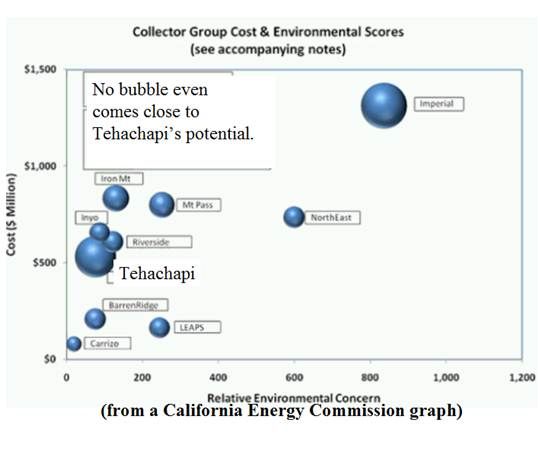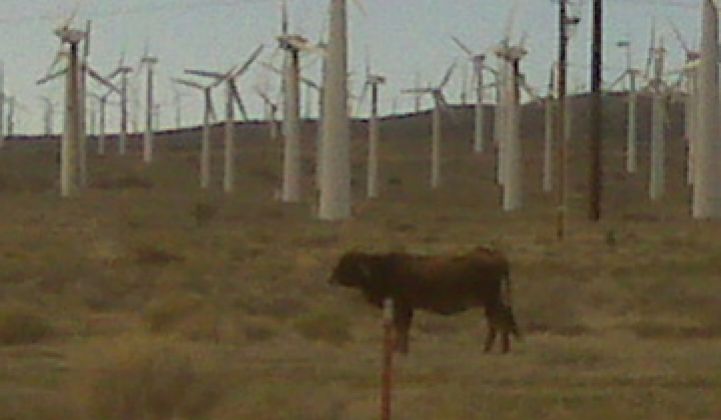There is more renewable energy potential in the Tehachapi-Mojave region than anyplace else in California. Developing that potential is crucial because California is committed to doubling its renewable capacity by 2020.
But development will not happen until the people of the Antelope Valley -- who will have to live with what developers build -- have their say.
To do so, an overflow crowd of stakeholders turned out for a Los Angeles County Planning Commission meeting at the Lancaster Public Library Saturday. Two hundred were admitted; as many more were turned away. It was a display of grassroots democracy that did the Antelope Valley proud.
After the history, goals and process of utility-scale renewables development were explained by the Planning Commission’s Thuy Hua, the meeting broke into groups. Attending stakeholders immediately set to work recording their concerns onto forms provided by the Commission until group discussions led by Commission facilitators began.
Passions and ideas were expressed, though too often with the logic of a person who interprets the heat from his burning house as a sign he must conserve water.
Renewable energy was not unpopular. In at least two groups, coal and nuclear met a unanimity of rejection otherwise reserved only for anything preceded by the word big, as in big turbines, big solar, big utilities or big transmission projects. The populist disenchantment with big government and big spending clearly infected anything utility-scale. Global, as in global climate change, mostly went unmentioned.
Several groups talked enthusiastically about distributed renewables. Apparently unaware of the state’s many renewables initiatives, many said California’s investment in utility-scale development should go to taxpayers for rooftop solar, solar water heating and other distributed generation. “Don’t give money to utilities,” one man said, “give it to us. It’s our money.”
There were proponents of building-integrated photovoltaics and space-based solar power plants. Unmentioned was the fact that Antelope Valley utility-scale renewables are ready to scale now, while the alternatives proposed are not.
Lack of knowledge is a predisposing factor to fear. A woman told another that backyard-scale wind is not like big turbines. “But how do you get the electricity to come to your house?” the listener replied, worried the electricity would go to the big utilities. A contractor said the dangers of big turbines are associated with huge underground vaults at the towers’ bases (though, in fact, turbine towers are planted in solid concrete foundations).
Several people talked about the potential dangers of turbine malfunctions. One attendee described the breaking apart of a test turbine in 2004. “Had anybody been near it,” he said, “they would have been dead.” Seven years is about three lifetimes in turbine technology yet there was no mention of newer, safer machines, nor were the words 'Fukushima disaster' or 'BP oil spill' heard in answer.
Someone insisted that land cleared for utility-scale solar would cause dust as problematic as smoke from the region’s chronic wildfires, but there was no mention of how renewables will mitigate the climate change that is worsening the wildfires.
For almost every group, a priority was protecting the Antelope Valley’s world-famous poppy reserve, home to California’s state flower. NextEra Energy and Element Power want to build turbines that will interfere with views of the poppies. One resident said she does not want a turbine between her and the flowers. Someone answered there might be a compromise. “Have you been to the poppy reserve?” was the heated reply.
Most groups were also passionately concerned for the region’s birds and its avian habitat. An attempt to explain how contemporary wind farms and modern turbines minimize avian harm was answered only with a very skeptical look.
At its heart, the message was that Antelope Valley’s people see the world they know changing too fast and they are going to do everything they can to slow the change. “We’re not willing to sacrifice our way of life,” someone said.
After much writing and talking, each group’s facilitator summarized what had been said on a poster-sized list of complaints and recommendations. Often a group member would try to add the spice back as the passionate rants were listed and neutralized, but a list can ultimately only place-hold the passion.
At the end of the group sessions, the ten facilitators each read their list to the entire room. The two-hour meeting was 40 minutes behind schedule. The facilitators were asked to read quickly. More passion dissipated.
There was a lot of NIMBY (Not In My Back Yard) and even some BANANA (Build Absolutely Nothing Anywhere Near Anything), but the sincerest sentiment was that there must be a better way to build renewables.
There is. They were taking part in it. It is a process in which the public’s will and the public good are reconciled in the most practical way possible. It foregoes the ideal, but hopefully avoids the taking up of arms.
To the county’s admission that development permits are being processed under the old rules, even as new ones are being drafted, one passionate man declared that something is being “lost forever” and called for a permitting moratorium. “They said they don’t have the answers,” he said. “Don’t move until we do.” Developers and renewables advocates, however, say progress is too slow to meet the state’s renewable energy goals.
 The County’s final plan will likely not satisfy all of the people who attended the meeting, nor will it allow every developer to build, but with luck, the public good will be served.
The County’s final plan will likely not satisfy all of the people who attended the meeting, nor will it allow every developer to build, but with luck, the public good will be served.



